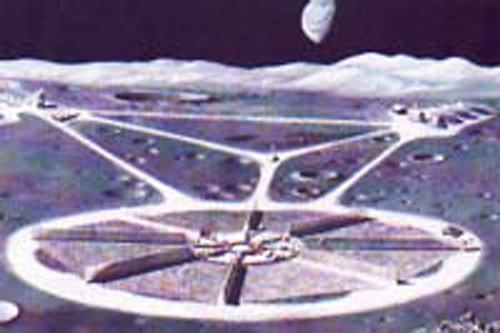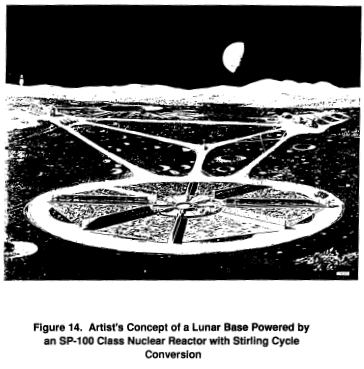|
|
|
|
Project Outreach - 1991 ..
|
|
|
SP100 Class Nuclear Reactor on the Moon Gary L. Bennett and Ronald C. Cull NASA Office of Aeronautics and Exploration Technology Washington, D.C. .
|
|
|
1991 Automation and Robotics for the Space Exploration Initiative : Results from Project Outreach By: Daniel Gonzales, David R. Criswell, Ewald Heer This Note describes the results of RAND's management of the direct solicitation component of the Space Exploration Initiative (SEI) Outreach Program, a program designed to solicit creative ideas from academia, research institutions, private enterprise, and the general public to help in defining promising technical areas and program paths for more detailed study. Eight panels were created to screen and analyze the submissions: space and surface power; space transportation systems, launch systems, and propulsion; automation and robotics; human support; structures, materials, mechanical systems, and in-situ processing; communications; information systems; and architectures and missions. Among the authors' recommendations are the following: (1) SEI robots, work environments, and systems should be systemically integrated; (2) structured-task robots should be developed for SEI; (3) NASA should adapt and develop advanced teleoperator robot control interfaces that enable telepresence; and (4) tradeoff studies must be done to select optimum mobility and navigational subsystems for SEI surface exploration robots. RAND Document Number: N-3284-AF/NASA Year: 1991 Pages: 95 ISBN/EAN: 0-8330-1994-5 Support
RAND Research — Buy This Product!
|
|
| 1991
Defense Technical Information Center Title : Automation and Robotics for the Space Exploration Initiative: Results from Project Outreach. Accession Number : ADA252567 Descriptive Note : Rand note,
Abstract : Review of the submissions of further research in A and R issues has led the Project Outreach A and R panel to make the following observations and to submit the following recommendations for consideration by the Synthesis Group: (1) Systematically integrate SEI robots, work environments, and systems; (2) Develop structured-task robots for SEI; (3) Adapt and develop advanced TOR(teleoperated robots) control interfaces that enable telepresence; (4) Evaluate the architectural implications of using TOR telepresence control in SEI; (5) Reevaluate and harmonize early SEI remote sensing data collection requirements with later SEI robotic mission requirements; (6) Conduct tradeoff studies to select optimum mobility and navigational subsystems for SEI surface exploration robots. Teams of complementary exploration robots should be considered in these tradeoff analyses; (7) Conduct tradeoff studies to determine the most cost-effective and productive development path towards autonomous robots; and (8) Review NASA's evaluations of A and R effort for Space Station Freedom. Descriptors : *SPACE EXPLORATION, *ROBOTICS, *AUTOMATION, SPACE MISSIONS, MARS(PLANET), MOON, UNITED STATES GOVERNMENT, PLANNING. Subject Categories : ASTRONAUTICS Distribution Statement : APPROVED FOR PUBLIC RELEASE
|
|
|
1992 Space and Surface Power for the Space Exploration Initiative Results from Project Outreach By: Calvin Shipbaugh, Kenneth A. Solomon, Daniel Gonzales, M. L. Juncosa, Theodore W. Bauer, Robert M. Salter This Note describes the findings of the Space and Surface Power panel, one of eight project panels evaluating submissions to the Space Exploration Initiative (SEI) Outreach Program, or Project Outreach. The submissions screened by the Space and Surface Power panel proposed systems that can be classified into at least one of five technical areas: (1) power generation (solar power, nuclear power, fuel cells, batteries, and "other"), (2) power transmission, (3) energy storage, (4) thermal management, and (5) handling. The panel screened 167 submissions and selected the 22 highest-ranked ones for further analysis. The submissions that appeared to offer the best overall potential dealt with nuclear power sources, power beaming, the development of in-situ resources (including the use of solar dynamic power), and thermal management. Some lower-ranked submissions also contained interesting and potentially useful system concepts, and the authors evaluated some concepts not suggested in the submissions, including rechargeable high-energy density batteries, high-speed flywheels, and superconducting storage rings. A number of space and surface power issues became apparent and were examined by the panel members: (1) environmental implications of SEI power systems, (2) use of in-situ materials, (3) nuclear vs. nonnuclear power, (4) start-up vs. evolutionary power needs, (5) manned vs. unmanned system requirements, and (6) development of new power transmission methods. RAND
Document No: N-3280-AF/NASA Year: 1992 Pages: xxiii, 94 ISBN: 0833020099
Support RAND Research — Buy This Product! Paperback Cover Price: $35.00
Space and Surface Power for the
Space Exploration Initiative:
|
|
| 1991
Defense Technical Information Center Accession Number : ADA256890 Title : Human Support Issues and Systems for the Space Exploration Initiative: Results from Project Outreach, Corporate Author : RAND CORP SANTA MONICA CA
Abstract : Human support issues hold the key to mankind's future in space. Success in resolving these issues and achieving the broader goals of the Space Exploration Initiative (SEI) will evolve only from a view of human space exploration as an ongoing enterprise where investments in research and development resolve operational problems, create infrastructure for future missions, and provide spinoffs that enrich the quality of American life. Fundamental questions of crew adaptability, tolerance, performance, and survival must be confronted SEI feasibility, continued support, and eventual success. Further, human support issues should be incorporated by life scientists early in (1) formulating preliminary requirements and guidelines, (2) planning missions, and (3) designing spacecraft. This should be done in ways that reflect the best judgment of both the space and life science communities. Properly posed requirements will facilitate the development of robust system concepts and design solutions that can be adapted to new knowledge, not always favorable, from R and D and test programs conducted on Earth and in space. Only in this manner can we identify (and reject) architectures that rely on potentially unstable, overly optimistic design solutions that exist in a narrow region separating feasibility from failure, and that can accommodate only favorable new findings. Descriptors : *SPACE EXPLORATION, *HUMAN FACTORS ENGINEERING, *LIFE SUPPORT SYSTEMS, *RADIATION PROTECTION, SPACE CREWS, ASTRONAUTS, SURVIVAL EQUIPMENT, PROTECTIVE EQUIPMENT, EXPOSURE(PHYSIOLOGY), TOLERANCES(PHYSIOLOGY), SOLAR RADIATION, HEALTH, RISK, COSMIC RAYS, SPACECRAFT. Subject Categories : ASTRONAUTICS
Distribution Statement : APPROVED FOR PUBLIC RELEASE
|
|
|
NASA AND Department of Defense Merge Recommendation 5
Gov. Info Library - Moon to Mars PDF (Archived) |
|
| 1997
In 1997, DoD, NASA, and the NRO created the Space Technology Alliance (STA) to “coordinate the development of affordable, effective space technologies for the greatest return on government funds.” The STA is making steady and significant progress in coordinating government S&T investment in space and has developed a prototype methodology for categorizing space technologies. Related Federal and Private Sector
Efforts.5 Currently identified technology efforts
Space Platforms (Archived - On request) |
|
|
Lunar Base Facilities Development and Operation by H.H.Koelle 1/1/1992 .
Abstract The subject of developing and operating of lunar facilities
has been covered widely during the last decades. This report attemps to
integrate these various contributions discussing specific details from
the systems viewpoint. This is mandatory for the simulation of the acquisition
process and the lunar base operation of extended periods. Lifetimes of
several decades have to be considered. The functions of lunar facilities
are defined and assigned to specific installations. Mass flows between
the elements of the lunar base are identified as well as their interrelations
with eachother and the facility elements. Some initial information is presented
on the 14 types of facilities identified. State-variables and performance
indicators are defined to compare alternative facility
Lunar Base Facilities Development and Operation PDF Format (Archived) |
|
| Space Transportation Systems,
Launch Systems, and Propulsion for the Space Exploration Initiative
Results from Project Outreach By: T. B. Garber, John R. Hiland, David T. Orletsky, Bruno Augenstein, Michael D. Miller This Note analyzes a number of transportation and propulsion options for Mars exploration missions. For space transportation options, the operational figures of merit that are of interest are (1) initial mass in low Earth orbit (IMLEO) and (2) transit times to and from the destination planet. It is desirable for both these parameters to have low values. Of the space transportation options examined, two approaches are most interesting: split missions, which use cargo spacecraft that follow low-energy trajectories to pre-position in Mars orbit the mass needed for Mars exploration and Earth return; and the use of in-situ propellants, which offer the potential for large reductions in IMLEO. To reduce IMLEO and trip time substantially, nuclear systems should be considered; a range of such systems is described. Almost all of the space transportation options evaluated would benefit from orbital transfer systems that can economically transfer large masses from low Earth orbit to high Earth orbits and Lunar space. In addition, all of these options would benefit from the development of propellant sources either on the Moon, on Martian systems, or both. Support RAND Research — Buy This Product! Paperback Cover Price: $45.00
Space Transportation Systems,
Launch Systems, and Propulsion for the Space Exploration
|
|
| Human Support Issues and Systems
for the Space Exploration Initiative
Results from Project Outreach By: Jerry Aroesty, R. Zimmerman, J. Logan This Note describes the findings of the Human Support panel, one of eight project panels evaluating submissions to the Space Exploration Initiative (SEI) Outreach Program, or Project Outreach. Fundamental questions of crew adaptability, tolerance, performance, and survival must be confronted squarely and systematically to assure SEI feasibility, continued support, and eventual success. Human support issues should be incorporated by life scientists early in formulating preliminary requirements and guidelines, planning missions, and designing spacecraft. The authors performed issue-oriented analyses to evaluate Project Outreach submissions in a context of some critical problems: (1) radiation protection for Mars missions requires further research in active shielding techniques; (2) space-based microgravity research is needed to improve the quantitative assessment of long-term effects and possible countermeasures; (3) life-support systems for long-term missions and planetary settlement will require bioregenerative technologies incorporating both ecological and biotechnological approaches; (4) medical care and health maintenance may best be handled by a team approach; (5) human factors need emphasis, since human behavior under prolonged stress, isolation, and confinement could compromise mission success; and (6) EVA (extra-vehicular activity) suits are essential to productive work in space or on the Lunar or Martian surfaces. Support
RAND Research — Buy This Product!
Human Support Issues and Systems
for the Space Exploration Initiative: Results from Project
|
|
Related Papers:
|
|
| FAIR USE NOTICE: This page contains copyrighted material the use of which has not been specifically authorized by the copyright owner. Pegasus Research Consortium distributes this material without profit to those who have expressed a prior interest in receiving the included information for research and educational purposes. We believe this constitutes a fair use of any such copyrighted material as provided for in 17 U.S.C § 107. If you wish to use copyrighted material from this site for purposes of your own that go beyond fair use, you must obtain permission from the copyright owner. | |
|
|


